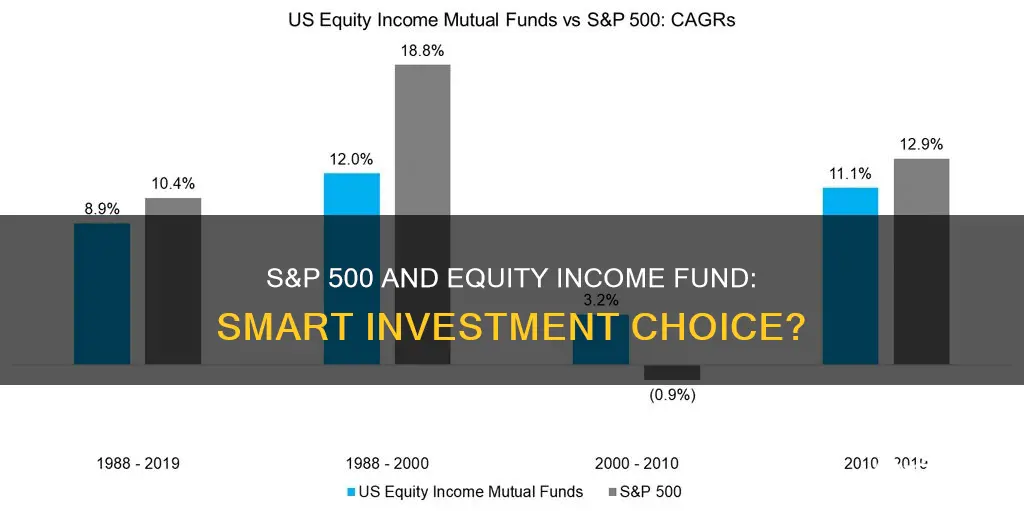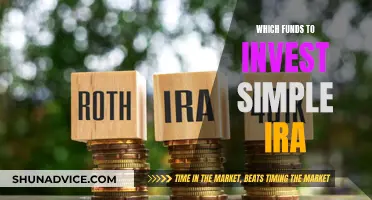
The S&P 500 is a stock market index that tracks the performance of 500 of the largest U.S. public companies by market capitalization. It is widely considered the best measure of the performance of the U.S. stock market. Investing in the S&P 500 can be done through index funds or exchange-traded funds (ETFs) that follow the index. Index funds are passively managed, aiming to replicate the performance of a market index, and are generally considered less risky than individual stocks. ETFs are similar but trade like stocks, with values that fluctuate throughout the day. Both index funds and ETFs are considered highly liquid, low-cost, and well-diversified investment options.
| Characteristics | Values |
|---|---|
| Type of investment fund | Mutual fund or ETF |
| Investment fund based on | An index |
| Index based on | A preset collection of stocks or bonds |
| Investment fund management | Passively managed |
| Investment fund theme | Specific theme e.g. geographic location, company size, sector, dividend payments |
| Number of stocks | 500 |
| Investment fund costs | Expense ratio, sales load |
What You'll Learn

What is the S&P 500?
The S&P 500 Index, or Standard & Poor's 500 Index, is a stock market index that tracks the stock performance of 500 of the largest companies listed on stock exchanges in the United States. It is one of the most widely followed equity indices and includes approximately 80% of the total market capitalization of U.S. public companies, with a market cap of over $39 trillion as of 2024.
The S&P 500 is a free-float weighted/capitalization-weighted index, meaning it is weighted by the number of shares available for public trading. It was launched in 1957 by the credit rating agency Standard and Poor's and is considered the best gauge of large U.S. stocks and the stock market overall.
The S&P 500 includes 500 leading U.S. publicly traded companies with a primary emphasis on market capitalization. The index features companies from various sectors, including technology, software, banking, and manufacturing. It is regarded as a leading barometer for judging the performance of the U.S. stock market.
While you cannot invest directly in the S&P 500, you can invest in one of the many funds that use it as a benchmark and track its composition and performance. These include index funds and exchange-traded funds (ETFs) offered by companies such as Vanguard, iShares, and State Street Corporation.
Judging Early-Stage Investments: VCs' Strategies and Secrets
You may want to see also

How to invest in the S&P 500
The S&P 500 is a stock market index that tracks the performance of 500 of the largest U.S. public companies by market capitalisation. It is considered a bellwether for the American stock market and a good indicator of the overall health of the U.S. stock market.
The easiest way to invest in the S&P 500 is to buy an S&P 500 index fund or exchange-traded fund (ETF). These funds aim to replicate the returns of the S&P 500 by tracking it, offering investors exposure to S&P 500 companies without the effort and risk involved in purchasing the individual stock of each company.
- Find your S&P 500 index fund: Look for a fund with a low expense ratio, which is the annual fee charged by the fund manager. You will also want to avoid a sales load, which is a commission charged by the fund manager.
- Go to your investing account or open a new one: You will need a brokerage account, such as a 401(k), an IRA or a regular taxable brokerage account, to purchase mutual funds or ETFs. If you are buying a mutual fund, find a broker that allows you to trade without a transaction fee. If you are buying an ETF, look for a broker that offers ETFs without commissions.
- Determine how much you can afford to invest: Figure out how much you are able to invest and how much you will add to your account regularly. The less you are able to invest, the more important it is to find a broker with low fees.
- Buy the index fund: Go to your broker's website and set up the trade, inputting the fund's ticker symbol and the number of shares you would like to buy. Many brokers allow you to set up an investing schedule to buy an index fund on a recurring basis.
Other things to consider:
- Diversification: While the S&P 500 is a good investment option, it only includes large-cap U.S. stocks. For a truly diversified portfolio, you should also invest in mid- and small-cap companies, international companies, and other asset classes such as bonds and cash.
- Timing: If you are investing for the long term (20-30 years), don't worry too much about the current state of the market. Focus on long-term performance and diversification.
- Costs: In addition to expense ratios, consider the cost of buying and selling the fund, as well as any taxes that may be triggered if the fund is held outside of tax-advantaged accounts.
Global Bond Funds: Diversify and Grow Your Investments
You may want to see also

Advantages and disadvantages of investing in the S&P 500
Advantages of Investing in the S&P 500
- Exposure to a wide range of industries, including technology, healthcare, finance, and consumer goods.
- Historically, the S&P 500 has shown strong long-term growth potential, outperforming many other investment options.
- Accessibility: Investing in the S&P 500 is possible through index funds, exchange-traded funds (ETFs), or mutual funds, making it suitable for both individual investors and those with limited investment knowledge.
- Professional management: The S&P 500 is managed by a committee that ensures the index accurately represents the U.S. large-cap stock market. This committee regularly reviews and adjusts the index constituents, providing investors with confidence in the index's composition.
Disadvantages of Investing in the S&P 500
- Market volatility: The S&P 500 is not immune to market volatility and can experience significant declines during periods of market downturns.
- Lack of individual stock selection: Investing in the S&P 500 means giving up control over individual stock selection, which may result in missing out on potential gains from stocks that outperform the broader market.
- Concentration in U.S. stocks: The S&P 500 is heavily weighted towards U.S.-based companies, resulting in limited exposure to international markets and reduced diversification benefits.
- Inclusion of underperforming stocks: Underperforming stocks may remain in the index for a certain period, impacting the overall performance during those periods.
Cion REIT: A Smart Investment Fund Move?
You may want to see also

Differences between S&P 500 index funds and ETFs
S&P 500 index funds and ETFs are great investment options, especially for new investors. However, there are some differences to note.
Trading Mechanism
The most significant difference between the two is that ETFs can be traded throughout the day like stocks, whereas index funds can only be bought and sold at the price set at the end of the trading day. This makes ETFs more suitable for intraday trading.
Minimum Investment
ETFs usually have a lower minimum investment than index funds. In most cases, you only need the amount to buy a single share to invest in an ETF, and some brokers even offer fractional shares. On the other hand, brokers often set higher minimums for index funds, which may be much higher than a typical share price.
Capital Gains Taxes
ETFs are generally more tax-efficient than index funds. When you sell an ETF, you're selling it to another investor, and the capital gains taxes on that sale are yours alone to pay. With index funds, when you redeem your investment, the fund manager may have to sell securities to generate the cash to pay you, and if this sale is at a gain, all investors with shares in the fund may owe capital gains taxes, even if they haven't sold their shares.
Cost
Both ETFs and index funds can have very low expense ratios. However, ETFs may also come with trading commissions, and index funds may have transaction fees, so it's important to compare costs before choosing. ETFs also incur a bid-ask spread cost when buying, but this is usually small for high-volume, broad-market ETFs.
Liquidity
ETFs are considered more liquid than index funds because they can be traded throughout the day.
Despite these differences, both options provide diversification, low costs, and strong long-term returns.
Pension Funds: Collective Investment Schemes Explained
You may want to see also

Best S&P 500 index funds
The S&P 500 is a stock market index that tracks the performance of 500 of the largest U.S. public companies by market capitalisation. It is regarded as a leading barometer for judging the performance of the U.S. stock market.
There are several ways to invest in the S&P 500, including buying individual stocks of companies in the S&P 500, or investing in an S&P 500 index fund or ETF.
When choosing an S&P 500 index fund, it is important to consider the expense ratio, inception date, dividend yield, and minimum investment. Here are some of the best S&P 500 index funds in the market:
- Fidelity 500 Index Fund (FXAIX): This fund has a very low expense ratio of 0.015% and no minimum investment requirement, making it accessible to investors of all account sizes. It has been in existence since 1988 and has a long history of competent management. The fund has a 10-year annualised return of 13.37% as of September 30, 2024, slightly outperforming the S&P 500 index's return of 13.15% during the same period.
- Vanguard 500 Index Fund Admiral Shares (VFIAX): With a low expense ratio of 0.04%, this fund offers relatively low fees. It has a minimum investment requirement and is one of the largest funds on the market with hundreds of billions in assets under management. VFIAX has a long history, having debuted in 2000, and is backed by Vanguard, a well-known name in the industry. The fund has a 10-year annualised return of 13.34% as of September 30, 2024.
- Schwab S&P 500 Index Fund (SWPPX): This fund offers a simple and low-cost way to track the returns of the S&P 500 index, with a very low expense ratio of 0.02% and no minimum investment requirement. It is accessible and affordable for long-term investing. The fund has a 10-year annualised return of 13.32% as of September 30, 2024.
- State Street S&P 500 Index Fund Class N (SVSPX): This fund is offered by State Street Global Advisors, the company that operates the biggest S&P 500 ETF. It has a lower net expense ratio of 0.16% compared to other options and a long track record of performance since its launch in 1992. The fund has a 10-year annualised return of 13.24% as of September 30, 2024.
- Fidelity ZERO Large Cap Index (FNILX): This fund is part of Fidelity's offering of mutual funds with no expense ratio. While it doesn't officially track the S&P 500, it follows the Fidelity U.S. Large Cap Index, which is similar. With no expense ratio, this fund is a low-cost option for investors. It has a 5-year annualised return of 16.0%.
- Vanguard S&P 500 ETF (VOO): This ETF tracks the S&P 500 index and is backed by Vanguard, a powerhouse in the fund industry. It has a low expense ratio of 0.03% and a 5-year annualised return of 16.0%.
- SPDR S&P 500 ETF Trust (SPY): The SPDR S&P 500 ETF is one of the oldest ETFs, having been founded in 1993. It is sponsored by State Street Global Advisors and tracks the S&P 500. The fund has a large amount of assets under management and a 5-year annualised return of 15.9%.
- IShares Core S&P 500 ETF (IVV): This ETF is sponsored by BlackRock, one of the largest fund companies. It tracks the S&P 500 and has a low expense ratio of 0.03%. The fund has a strong record, having been in existence since 2000, and a 5-year annualised return of 16.0%.
- Schwab S&P 500 Index Fund (SWPPX): With tens of billions in assets under management, this mutual fund has a strong record dating back to 1997. It is sponsored by Charles Schwab, a respected name in the industry, and has a very low expense ratio of 0.02%. The fund has a 5-year annualised return of 16.0%.
International Funds: Taxable Accounts Worth the Investment?
You may want to see also
Frequently asked questions
The S&P 500 is a stock market index that tracks the performance of 500 of the largest U.S. public companies by market capitalization. It represents nearly 80-85% of the total capitalization of the U.S. stock market and is considered the leading barometer for judging the performance of the U.S. stock market.
Investing in the S&P 500 offers instant diversification and is generally considered less risky than purchasing individual stocks directly. It provides exposure to some of the world's most dynamic and largest U.S. companies across various sectors. Additionally, the S&P 500 has consistently performed well over the long term.
You can invest in the S&P 500 through index funds or exchange-traded funds (ETFs) that track the index. These funds aim to replicate the returns of the S&P 500, offering investors broad exposure to the constituent stocks. You can purchase these funds through a taxable brokerage account, a 401(k), or an IRA. Alternatively, you can invest directly in individual stocks of S&P 500 companies, but this requires more research and monitoring of individual stock performance.
Some popular S&P 500 index funds include:
- SPDR S&P 500 ETF Trust (SPY)
- Vanguard S&P 500 ETF (VOO)
- iShares Core S&P 500 ETF (IVV)
- Fidelity 500 Index Fund (FXAIX)
- Schwab S&P 500 Index Fund (SWPPX)







